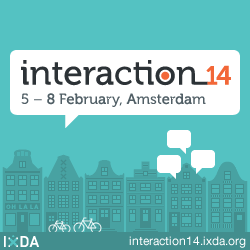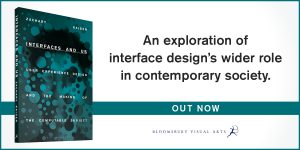Videos of Day 2 of Interaction14 conference

Body Languages of Interaction Design [38:53]
Keynote by Irene Au
Design is both art and science, yet while we teach methods and practices for hard design skills, we don’t teach practices that address the art of design, which is often mystified as “creative genius”.
Irene’s talk will explore how through meditation and yoga we can acquire the most critical skills we need to be great designers: how might we become more focused so we can deliver the one or two key features that would be most useful; how might we more effectively cultivate access to our empathy and insight to create usable products; and how we can be more innovative and bring inspiration, delight, and heart to the people who use the products we design.
> Full description
Designing to unleash playfulness and curiosity [30:13]
Jan Willem Huisman, Founder, IJsfontein Interactive Media
Curiosity and playfulness are deeply embedded in our mind and feed the urge for learning and exploring. It’s this behavior that pushes intelligent species forward in their evolution. When Jan Willem graduated multimedia design at the Royal College of Arts in London, he was fascinated by this phenomenon and started his quest to unleash this primal source of energy.
In our current educational system curiosity and playfulness are often seen as inconvenient. However, the digital age gives us the opportunity to redesign the way we interact so we can evoke this energy instead of restricting it. In this presentation Jan Willem shares his quest and his findings on designing to unleash playfulness and curiosity.
> Full description
The Language of Physical Theater [37:58]
Mary Constance Parks
The language of physical theater is like the languages of typography and animation, but more obviously connect to the human.
In this talk, three basic principles from physical theater will be presented that function as high-level constraints on how physically-trained actors can capture peoples’ attention and maintain rhythm and focus during story-telling in a performance. These principles have correlates in film, animation, typography, and spoken discourse. In this talk, the principles will be demonstrated, and the attendees will be encouraged to find parallels between the physical theater structures and aspects of Interaction Design.
> Full description
Communicative Surfaces [15:07]
Svenja Keune, Founder, EmotionLab
What kind of effects do interfaces+interactions have to our everyday life, our senses, our behaviour? How can textiles make a change?
As the world of communication is more and more immaterialized, this talk focuses on haptic and emotional languages of interaction. Svenja is working with textiles and technology, her special interest is the humans´ relationship to an object and vice versa.
> Full description
Design Thinking at Scale [39:09]
Surya Vanka, Director of User Experience at Microsoft
In his talk, Surya unpacks the five principles underlying Microsoft’s innovative integrated user experience model. He showcases a ten year journey of developing an authentic design voice and language, and describes how this was born from clarity of purpose and a shared sense of mission. He offers insights drawn from the cultural transformation of a large company that was known for technological prowess into one that is driven by user experience.
> Full description
Designing with Sensors: Creating Adaptive Experiences [32:30]
Avi Itzkovitch, Owner, IoT News Network
Avi Itzkovitch presents core concepts for utilizing smart device technologies and sensor data in order to understand context, and helps you add “Adaptive Thinking” to the UX professional’s toolset when designing experiences. In his presentation, Avi demonstrates the importance of understanding context when designing adaptive experiences, gives ideas on how to design adaptive systems and most important, inspires designers to think how smart device technology and context aware applications can enhance the user experience with adaptivity.
> Full description
Evangelizing and Designing Voice User Interface: Adopting VUI in a GUI world [37:37]
Stephen Gay and Susan Hura
Apple’s Siri and Google Now have ignited consumers’ interest in voice user interface (VUI) by delivering valuable and delightful customer experiences. Innovative companies can leverage VUI solutions to create a competitive advantage. But how do you drive the adoption of VUI in an organization with a long GUI-only history? Stephen Gay and Susan Hura share the frameworks they used to evangelize VUI, offer key insights and design principles to help you start your own grassroots VUI movement, and provide best practices and a VUI brainstorming canvas.
> Full description
The Executioner’s Tale [21:36]
Christina Wodtke
Ideas are cheap. Execution is everything.
Christina has spent her career attacking impossible tasks: at Yahoo, taking on the giant Google at search; at Linkedin, bringing people to participate daily at a site about resumes; at MySpace, reinventing the profile; at Zynga, building a social network for play. Some succeeded some did not. All had one thing in common: large groups of people all working toward a single goal. Lean can tell you what to build and Agile tells you how to build it–but neither tell you how to build it as a team. How do you build consensus? How do you inspire outlandish dreams? How do you create accountability in teams? Christina shares her toolkit for clarity and commitment.
> Full description
Jam session
Designing a Better Death / A good Death [Not yet online]
Navit Keren, UX at Huge
> Full descriptionHere, there be dragons: a fable of UX in the realm of Enterprise SaaS applications [Not yet online]
Krishna Brown, “Billy”
> Full descriptionHow the London Underground map helped us solve the problems of one of the largest financial institutions in the world [Not yet online]
Kent Eisenhuth, Lead Designer at Electronic Ink
> Full description
Bad Design Advice [31:48]
Paolo Malabuyo, User experience design leader, Mercedes-Benz Research & Development North America
Paolo share ssome of the worst UX design advice he has received and what lessons he has really learned from them.
Sometimes you get good advice, often bad advice, and every so often you get bad advice masquerading as good advice. Here are a few in the last category that Paolo has received over the years with an explanation as to why they’re bad and what lessons he really learned from them.
> Full description
Designing for privacy in mobile and web apps [35:44]
Amber Case, Director at Esri
This talk covers best practices for designing web and mobile apps with the privacy of individual users in mind. Privacy has been an even bigger issue with location-based apps, and we ran into it head-first when we began work on Geoloqi. Designing an interface that made one’s personal empowering instead of creepy was our goal. The stories from our design decisions with Geoloqi are also included in this talk.
> Full description
Why Executives Obsess Over Icons (and other insights from the boardroom!) [26:29]
Uday Gajendar, Principal Designer at Citrix
This talk offers insights from real situations working with top-level executives (including the CEO) on major UX projects. We constantly clamor for a seat at “the table” but what happens when you actually get there? How do you assert yourself as an authority of design that is perceived and valued as such, not someone who “makes pretty pictures™ or “plays with stickies’? Gajendar’s goal in this talk is to set up design leaders for success by raising their executive IQ. He presents an “executive persona” and various contexts for dealing with executive inputs, with lessons learned.
> Full description
Designing without users [25:47]
Ian Fenn
Learn how to still get users into your design, even if your client has denied access to them.
> Full description
The Humane Enterprise [35:35]
Scott Nazarian, Creative Director at frog design
What new capabilities and service offerings might become possible if we can imbue the foundation ”enterprise software and hardware” with human-machine elegance? Can we reconcile deep computing structures and practices with the more “nodal” or highly mobile and personal sensibility that defines contemporary, daily computation? Interaction and experience designers can to transform human-computer interaction within the enterprise services layer to accomplish this.
> Full description
The Shift: UX Designers as Business Consultants [34:17]
Davide Casali, Experience Designer at Automattic
Businesses are increasingly adopting user-centered approaches to create experiences, moving UX design to be one of the core activities driving the company strategy and operations.
This is an incredibly valuable opportunity that we designers can take to step up and contribute to create the great experiences and services they envision, taking our vision, tools and understanding to a different level. But we need to learn the new skills to play at this table, a table that’s often speaking a different language with a lot of politics and different stakeholders.
> Full description
On earning respect and doing what we love [30:06]
Santiago Bustelo, Design Director, Keikendo
Our career and our professional relationships are a design problem that we can solve with a design process.
How can we designers get the professional respect we want? This talk explores several topics and models that can help not only you, but the design community as well, along the way.
> Full description
The De-intellectualization of Design [46:46]
Keynote by Daniel Rosenberg
During this keynote, Dan Rosenberg intertwines two frequently misunderstood topics relevant to the practice of UX design in the coming decade, which he faces daily in his consulting and educator roles. The first is to debunk a pervasive set of fallacies regarding the differences between designing enterprise solutions and consumer products. The second is the trend towards deintellectualization in UX practice and education, that both diminishes the UX professional value and also reduces our collective capacity to solve the hardest class of design problems. While these topics might seem disconnected, come to this keynote to gain insight into why they are tightly coupled and how both could affect your IXD practice in the future.
> Full description



